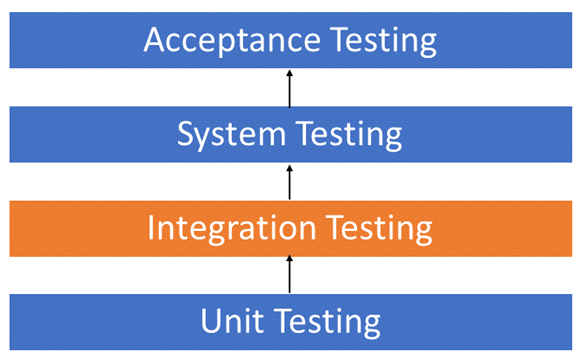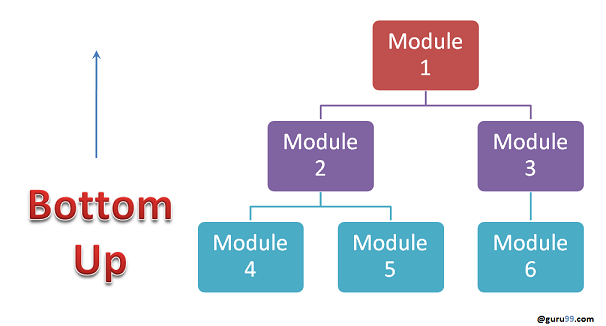What is Integration Testing?
INTEGRATION TESTING is defined as a type of testing where software modules are integrated logically and tested as a group. A typical software project consists of multiple software modules, coded by different programmers. The purpose of this level of testing is to expose defects in the interaction between these software modules when they are integrated
Integration Testing focuses on checking data communication amongst these modules. Hence it is also termed as ‘I & T’ (Integration and Testing), ‘String Testing’ and sometimes ‘Thread Testing’.
- What is Integration Testing?
- Why do Integration Testing?
- Example of Integration Test Case
- Approaches, Strategies, Methodologies of Integration Testing
- Big Bang Approach:
- Incremental Approach
- What is Stub and Driver?
- Bottom-up Integration
- Top-down Integration:
- Hybrid/ Sandwich Integration
- How to do Integration Testing?
- Brief Description of Integration Test Plans:
- Entry and Exit Criteria of Integration Testing
- Best Practices/ Guidelines for Integration Testing
Why do Integration Testing?

Although each software module is unit tested, defects still exist for various reasons like
- A Module, in general, is designed by an individual software developer whose understanding and programming logic may differ from other programmers. Integration Testing becomes necessary to verify the software modules work in unity
- At the time of module development, there are wide chances of change in requirements by the clients. These new requirements may not be unit tested and hence system integration Testing becomes necessary.
- Interfaces of the software modules with the database could be erroneous
- External Hardware interfaces, if any, could be erroneous
- Inadequate exception handling could cause issues.
Click here if the video is not accessible
Example of Integration Test Case
Integration Test Case differs from other test cases in the sense it focuses mainly on the interfaces & flow of data/information between the modules. Here priority is to be given for the integrating links rather than the unit functions which are already tested.
Sample Integration Test Cases for the following scenario: Application has 3 modules say ‘Login Page’, ‘Mailbox’ and ‘Delete emails’ and each of them is integrated logically.
Here do not concentrate much on the Login Page testing as it’s already been done in Unit Testing. But check how it’s linked to the Mail Box Page.
Similarly Mail Box: Check its integration to the Delete Mails Module.
| Test Case ID | Test Case Objective | Test Case Description | Expected Result |
|---|---|---|---|
| 1 | Check the interface link between the Login and Mailbox module | Enter login credentials and click on the Login button | To be directed to the Mail Box |
| 2 | Check the interface link between the Mailbox and Delete Mails Module | From Mailbox select the email and click a delete button | Selected email should appear in the Deleted/Trash folder |
Approaches, Strategies, Methodologies of Integration Testing
Software Engineering defines variety of strategies to execute Integration testing, viz.
- Big Bang Approach :
- Incremental Approach: which is further divided into the following
- Top Down Approach
- Bottom Up Approach
- Sandwich Approach – Combination of Top Down and Bottom Up
Below are the different strategies, the way they are executed and their limitations as well advantages.
Big Bang Testing
Big Bang Testing is an Integration testing approach in which all the components or modules are integrated together at once and then tested as a unit. This combined set of components is considered as an entity while testing. If all of the components in the unit are not completed, the integration process will not execute.
Advantages:
- Convenient for small systems.
Disadvantages:
- Fault Localization is difficult.
- Given the sheer number of interfaces that need to be tested in this approach, some interfaces link to be tested could be missed easily.
- Since the Integration testing can commence only after “all” the modules are designed, the testing team will have less time for execution in the testing phase.
- Since all modules are tested at once, high-risk critical modules are not isolated and tested on priority. Peripheral modules which deal with user interfaces are also not isolated and tested on priority.
Incremental Testing
In the Incremental Testing approach, testing is done by integrating two or more modules that are logically related to each other and then tested for proper functioning of the application. Then the other related modules are integrated incrementally and the process continues until all the logically related modules are integrated and tested successfully.
Incremental Approach, in turn, is carried out by two different Methods:
- Bottom Up
- Top Down
Stubs and Drivers
Stubs and Drivers are the dummy programs in Integration testing used to facilitate the software testing activity. These programs act as a substitutes for the missing models in the testing. They do not implement the entire programming logic of the software module but they simulate data communication with the calling module while testing.
Stub: Is called by the Module under Test.
Driver: Calls the Module to be tested.
Bottom-up Integration Testing
Bottom-up Integration Testing is a strategy in which the lower level modules are tested first. These tested modules are then further used to facilitate the testing of higher level modules. The process continues until all modules at top level are tested. Once the lower level modules are tested and integrated, then the next level of modules are formed.
Diagrammatic Representation:

Advantages:
- Fault localization is easier.
- No time is wasted waiting for all modules to be developed unlike Big-bang approach
Disadvantages:
- Critical modules (at the top level of software architecture) which control the flow of application are tested last and may be prone to defects.
- An early prototype is not possible
Top-down Integration Testing
Top Down Integration Testing is a method in which integration testing takes place from top to bottom following the control flow of software system. The higher level modules are tested first and then lower level modules are tested and integrated in order to check the software functionality. Stubs are used for testing if some modules are not ready.
Diagrammatic Representation:

Advantages:
- Fault Localization is easier.
- Possibility to obtain an early prototype.
- Critical Modules are tested on priority; major design flaws could be found and fixed first.
Disadvantages:
- Needs many Stubs.
- Modules at a lower level are tested inadequately.
Sandwich Testing
Sandwich Testing is a strategy in which top level modules are tested with lower level modules at the same time lower modules are integrated with top modules and tested as a system. It is a combination of Top-down and Bottom-up approaches therefore it is called Hybrid Integration Testing. It makes use of both stubs as well as drivers.

How to do Integration Testing?
The Integration test procedure irrespective of the Software testing strategies (discussed above):
- Prepare the Integration Tests Plan
- Design the Test Scenarios, Cases, and Scripts.
- Executing the test Cases followed by reporting the defects.
- Tracking & re-testing the defects.
- Steps 3 and 4 are repeated until the completion of Integration is successful.
Brief Description of Integration Test Plans:
It includes the following attributes:
- Methods/Approaches to testing (as discussed above).
- Scopes and Out of Scopes Items of Integration Testing.
- Roles and Responsibilities.
- Pre-requisites for Integration testing.
- Testing environment.
- Risk and Mitigation Plans.
Entry and Exit Criteria of Integration Testing
Entry and Exit Criteria to Integration testing phase in any software development model
Entry Criteria:
- Unit Tested Components/Modules
- All High prioritized bugs fixed and closed
- All Modules to be code completed and integrated successfully.
- Integration tests Plan, test case, scenarios to be signed off and documented.
- Required Test Environment to be set up for Integration testing
Exit Criteria:
- Successful Testing of Integrated Application.
- Executed Test Cases are documented
- All High prioritized bugs fixed and closed
- Technical documents to be submitted followed by release Notes.
Best Practices/ Guidelines for Integration Testing
- First, determine the Integration Test Strategy that could be adopted and later prepare the test cases and test data accordingly.
- Study the Architecture design of the Application and identify the Critical Modules. These need to be tested on priority.
- Obtain the interface designs from the Architectural team and create test cases to verify all of the interfaces in detail. Interface to database/external hardware/software application must be tested in detail.
- After the test cases, it’s the test data which plays the critical role.
- Always have the mock data prepared, prior to executing. Do not select test data while executing the test cases.

